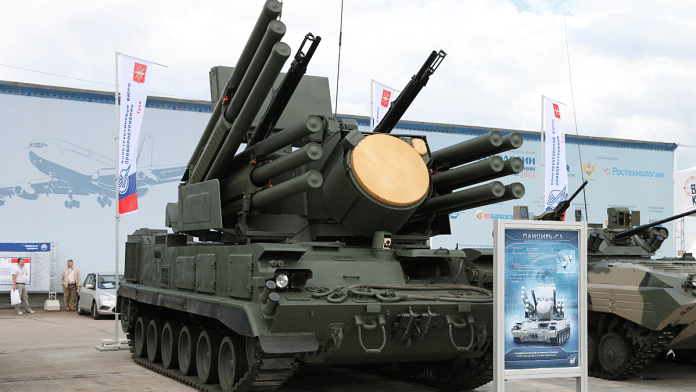New Delhi: In what could be a new deal in the making between the two time-tested partners, Russia is offering its latest generation of Pantsir mobile air defence system to India.
State-run Bharat Dynamics Limited (BDL) and the Rosoboronexport of Russia last week entered into a MoU for cooperation on Pantsir variants.
The tie up comes as the Indian Army scouts for Carrier Air Defence Tracked (CADET) systems, with a minimum of 50 percent indigenous content, to deploy them with mechanised columns, as reported by ThePrint in August.
Defence sources said that Russia is offering the latest version of Pantsir. However, it is not yet clear which version Moscow is referring to as there are multiple editions with the latest designed to operate in very cold temperatures.
However, Russia has also showcased a Pantsir-S1 on a tracked GM-352 chassis. Produced by Russia’s Mytishchi Machine-Building Plant, the GM series can accommodate multiple systems from infantry combat vehicles to Pantsir.
Interestingly, the CADET chassis, when chosen, will afterwards, be a common link for other air defence projects that the Army has been looking at. The Army will also buy more CADET systems with upgrades put in place.
The basic CADET platform—conceptualised as a box-shaped, tracked chassis with a raised structure—will provide space inside its body to accommodate a crew of four and equipment. There will be attachment points outside its body for mounting various equipment and structures associated with current and future air defence systems.
However, this is not the first time Pantsir is in reckoning for an Indian Army project.
Way back in 2013, it was one of the contenders for the Army’s plans to have a similar air defence system.
In the 2013 global tender, the Army had shortlisted three companies— South Korea’s Hanwha Defense Systems, which offered its Hybrid Biho system, and Russian companies Almaz Antey, which offered its upgraded Tunguska system, and KBP Tula, which offered its Pantsir system.
The bid was eventually won by the South Korean firm but the deal never went through due to issues which officials say was because of “indigenous content”. Moscow had objected to it being pushed out in 2018 during the India-Russia Inter-Governmental Commission on Military Technical Cooperation in New Delhi.
Army sources said that the Biho system continues to be a key system and that there is a tracked version as well.
The Army will deploy the CADET in all terrains such as plains, deserts, semi-deserts, and high-altitude and mountainous areas of up to 5,000 m.
Incidentally, China has just introduced the latest version of its SWS2 35mm self-propelled anti-aircraft gun (SPAAG), combining artillery and missile components to counter a range of aerial threats. Built on the VN-1 8×8 armored vehicle platform, and not tracked, this modified SWS2 system focuses on countering drones, cruise missiles, and low-flying aircraft.
The Pantsir development started in 1989 as a replacement for the 2K22 Tunguska air defence system. Following the collapse of the Soviet Union, the system underwent multiple changes and the finalised version entered into service in 2003.
Since then, it has been used by a number of countries and has been heavily deployed in Syria and also in the ongoing Russia-Ukraine conflict. It is reported that several Pantsir systems are deployed on the rooftops of key buildings in Russia including where Russian President Vladimir Putin stays.
The US smuggled a Pantsir-S1 out of Libya in June 2020 after it was captured from forces aligned with Russia-backed Khalifa Haftar, according to CSIS. American forces reportedly transferred the Pantsir-S1 from Zuwarah International Airport to Ramstein Air Base in Germany.
Several upgraded Pantsir variants are in development. The Pantsir-SM has a detection range of up to 75 km and an engagement range of 40 km. It was first tested in early 2019 and is said to be in service.
An export variant, the Pantsir-S1M, incorporates a new missile and features an engagement range of 30 km. The firepower of the Pantsir-S1 consists of twelve 57E6 surface-to-air guided missiles and two 2A38M30-mm automatic guns developed from the two-barreled 30mm GSh-30 gun.
(Edited by Tony Rai)
Also Read: Army scouts for 90 tracked air defence systems with minimum 50% indigenous content






